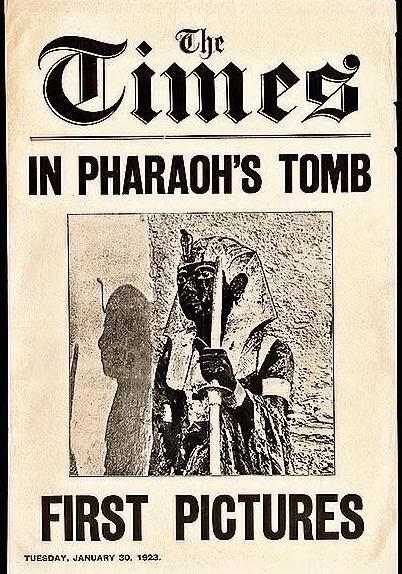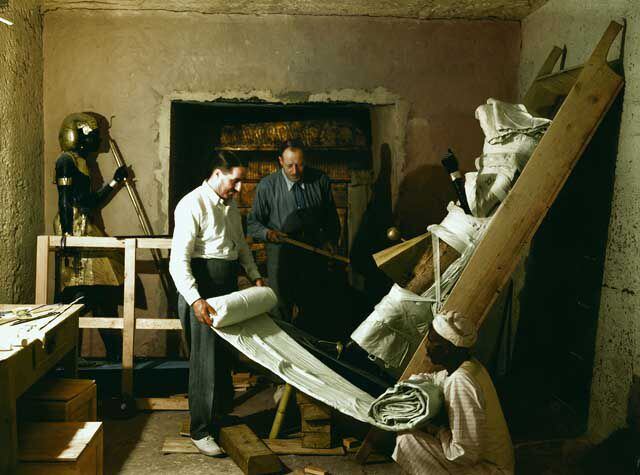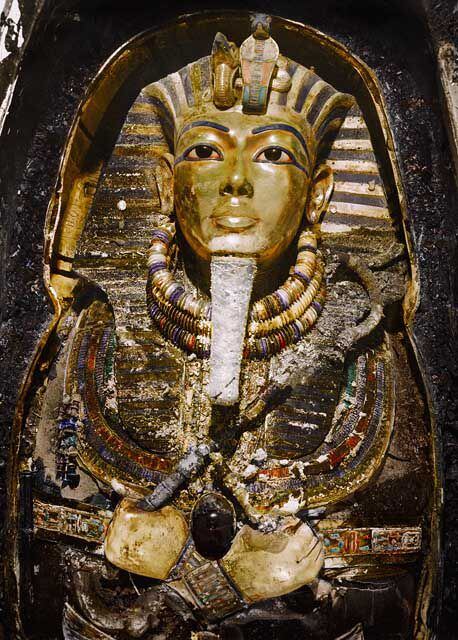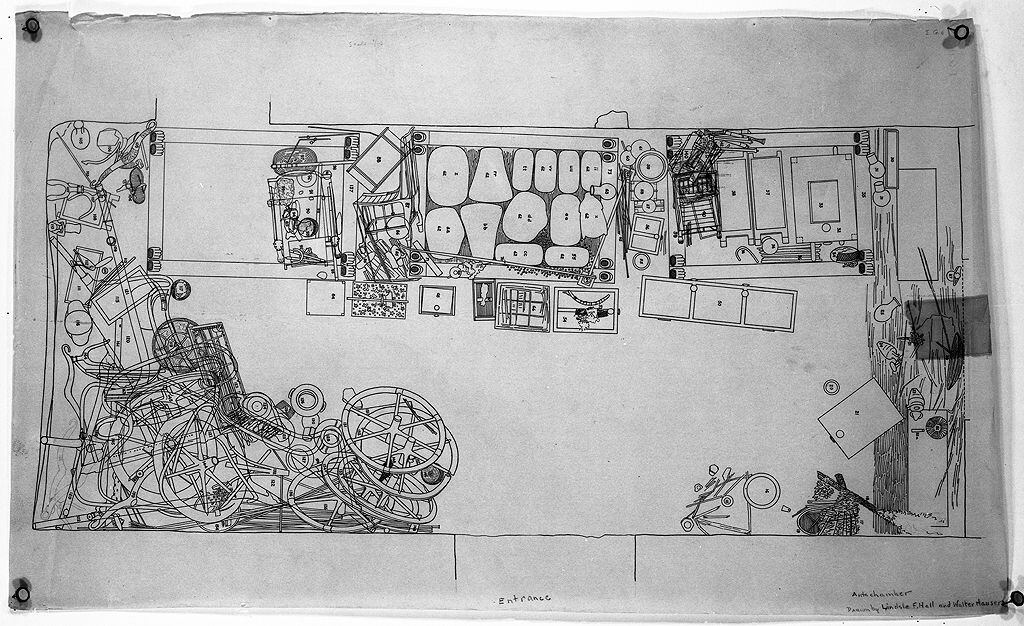On November 6, 1922, the Earl of Carnarvon, George Herbert, received a telegram. “we have finally done discovery wonderful in Valley. Magnificent tomb with intact seals. Covered until your arrival. Congratulations”. It was sent by Howard Carter, the archaeologist in charge of the explorations that the earl financed in the Valley of the Kings, north of Luxor, in Egypt.
LOOK: A bust of Tutankhamun will be auctioned in London, despite complaints from Cairo
Three weeks later, Lord Carnarvorn arrived in Egypt from his native England. The trip was not strange for him, since the African nation had become his second home due to a medical prescription that advised him to escape the cold British winter.
On November 24, Carter and Herbert began to descend the ladder that the archaeologist had found under the huts of the slaves who had built the tomb of Ramses VI. They found a door, at the top it had the seal of a jackal with nine slaves with their hands tied, a symbol that they were before a royal tomb. At the bottom, the hieroglyphs of a second seal could be translated as “Tutankhamun”.
The excavation continued for two more days, until reaching a second gate. The darkness was absolute, but Carter was able to make a hole in one of the corners of the door, lit a candle to check that there was enough oxygen to continue, placed it on the hole and there it was.
“As my eyes adjusted to the light, the details of the inner room slowly emerged from the darkness, strange animals, statues and gold, everywhere the glitter of gold”, Carter narrates in his memoirs about that moment. The archaeologist was stunned and seized by a surprise that stole his speech. “Can you see anything?asked an impatient Lord Carnarvon.
“yes wonderful thingsCarter responded.
They had found the virtually intact tomb of a pharaoh. The closest a man can get to time travel. More than 3,200 years in the past, to Ancient Egypt, to be precise.
FEVER FOR EGYPTOLOGY
Carter’s discovery, and his impeccable dissemination strategy in this regard, made this find not only one of the most important milestones in the history of universal archaeology, but also a social phenomenon.
An exclusivity contract for 5,000 pounds sterling at the time with “The London Times” allowed the British newspaper to bring details to the audience that a media outlet could rarely have access to in this type of event. The riches found inside the tomb also provided invaluable data that allowed an even better understanding of ancient Egyptian society.

“The discovery of the tomb of Tutankhamun marked a before and after in Egyptology and the general perception of the study of the past”, he comments to Trade Antonio Javier Morales, professor of Egyptology at the University of Alcalá and director of the Middle Kingdom Theban Project in Deir el-Bahari, Luxor, Egypt.
“the tomb of Tutankhamun It was a unique discovery because, among other things, it was almost intact, something that had not happened in the Valley of the Kings in a century and that allowed a detailed study of the figure of a king who, moreover, held a very particular position in the history of the Egypt of the Eighteenth Dynasty and the imperial age“, Explain.

The son of Pharaoh Akhenaten, Tutankhaton – his original name meaning “The Living Forms of the Aten” – ruled between 1334 and 1325 BC, a period known as the New Kingdom in Egyptian history. He was only 8 or 9 years old when he came to the throne with the name of Tutankhamunwhich translates into Spanish as “living image of ammon”.
The pharaoh died very young, it is estimated that he was barely 18 years old, and the possible causes range from a chariot accident to possible malaria. Of his reign, the decision to reverse the reform launched by his father in which only the image of the god Aten was worshiped and return to the Egyptian polytheistic tradition stands out.
“(Akhenaten) banned and persecuted cults other than the Aton sun disk cult and developed a whole new ideology based on the life-giving power of the Atonian deity. The king and the royal family thus became the only mediators between the god and humanity. After a failed attempt at a religious revolution that did not come to fruition, Tutankhamun he changed his name, returned to traditional religion and became a true renovator of the quasi-heretical religion imposed by his father”, explains Morales.
Within this reform, in addition to increasing its proximity to the different temples of Ancient Egypt, Tutankhamun restored Thebes as capital.
“The discovery of his tomb not only meant the revelation of his existence, a better knowledge of the time and the understanding of his role as a restorer of traditional religion, but also allowed us to learn more about the craft production of the period, the traditions religious and rituals of the kings and the fascination of the ancient Egyptians for the safety and intimacy of the corpse of their kings, true gods on earth who should have enjoyed all the luxury of personal objects (funerary trousseau), traditional rituals and magical texts (inscriptions on the walls, sarcophagus, coffin, canopic box with its internal organs after mummification, jewelry, jars, etc.) to be able to reach eternal life in the afterlife”, adds the expert.

THE FIGURE OF CARTER
Undoubtedly the genius of the discovery of the tomb of Tutankhamun reached that level for the role played by Howard Carter. The archaeologist stood out both for his methodical and meticulous work and for the fantastic dissemination campaign he undertook to publicize the fact.
The mystery and magnificence of the discovery even fed a series of legends around the figure of Tutankhamun, arriving to speak of the curse of the pharaoh. What certainly turned out to be a resource of some media for exploiting the issue in the face of impotence due to the exclusivity enjoyed by “The London Times”.
“That, on the one hand, meant that The Times was able to offer privileged, up-close and very detailed information that encouraged readers and followers of the discovery phenomenon. On the other hand, however, it also meant that newspapers like The New York Times had to invent stories and anecdotes, which contributed to the growth of this archaeological legend and, among others, to the emergence of the famous story of the “curse of Tutankhamun”, Morales points out.

But back to Carter’s work, the archaeologist tried to record as many details as possible during his exploration. In total, 5,398 objects were cataloged during a decade of relentless work on the tomb.
“Howard Carter had been drawing during his previous campaigns and, in fact, many of his drawings, diagrams, drafts or watercolors have been used to discover more monuments of the time (which are not in the same condition today) and even to understand the fauna and flora of his time, as well as the Pharaonic era that he liked to represent”, says the expert.
The most symbolic of the objects found was, without a doubt, the pharaoh’s death mask, made with more than six kilos of gold. But they also highlight a leopard skin cloak, four game boards, six chariots, 30 wine jugs and 46 bows.

In addition, Morales points out, the works on Tutankhamun brought together professionals specialized in restoration, chemistry, photography, ceramics, architecture, drawing and philology over the years.
“In a way, the discovery of the tomb of Tutankhamun finds no parallel in the history of archaeology”, assures the expert. “Not only because of its uniqueness and the way in which the discovery was made and the news transferred from the site to newspapers and homes and institutions, but also because of the “intact tomb” condition and for all the funerary trousseau that allowed us to recover. Perhaps the study of Pompeii and the recovery of the city as well as the few human remains that the eruption of Mount Vesuvius allowed to recover, the discovery of the army of eight thousand terracotta soldiers of the first Chinese emperor, Qin Shi Huang or the study from the city of Knossos from the Bronze Age in Crete could be similar examples, but without the same publicity and impact, as the discovery of the tomb of the boy-king”.
LIVING HISTORY
Last Wednesday the Griffith Institute of the University of Oxford, on the occasion of the 100 years of the discovery, inaugurated an exhibition where the notes and drawings of the tomb made by Carter are exhibited.
The exhibition, installed in the Weston Library of the British university but also available on its website, will be open until February 2023.
The Griffith Institute states that Carter’s notes were deposited at the institution by the archaeologist’s niece, Phyllis Walker, shortly after he died in 1939.
In the exhibition you can find everything from diagrams of the tomb and its accesses drawn up by Carter himself to alternative accounts, photographs of the objects and of the excavation work.

“The collection is exceptional, since it not only deals with formal elements such as his notes, diaries and studies, but also shows us a Carter interested in art, iconography, pigments, the natural forms of birds and of plants, which leads us to think that his studies of the objects and remains found in the tomb of Tutankhamun are very insightful, appropriate and accurate”, emphasizes Morales.
Source: Elcomercio

:quality(75)/cloudfront-us-east-1.images.arcpublishing.com/elcomercio/OAVVETRNPREWVFVQBWVMCPYS2Y.jpg)

:quality(75)/cloudfront-us-east-1.images.arcpublishing.com/elcomercio/7XBPETG4ONAO5DIYUNGJU2NXXQ.jpg)
:quality(75)/cloudfront-us-east-1.images.arcpublishing.com/elcomercio/4A4LBIKHGNA4NMAU3RAUINZ7PI.png)

:quality(75)/cloudfront-us-east-1.images.arcpublishing.com/elcomercio/GAZW3YDH25GIBFWZQPEQZZJVQ4.jpg)
